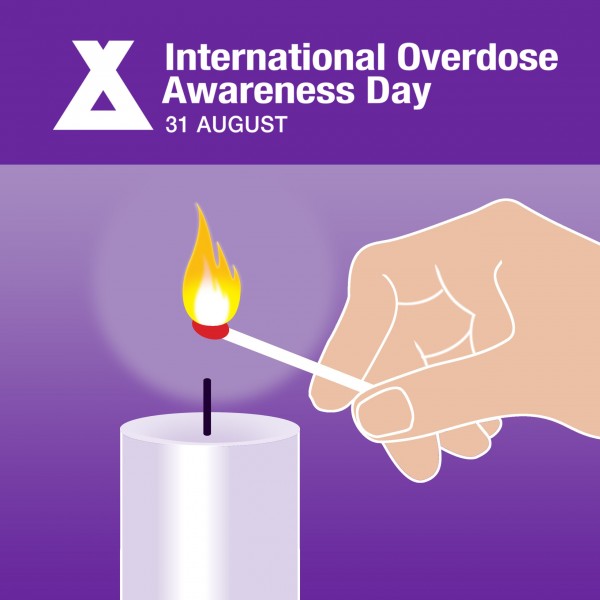“If someone overdoses once, twice, even fifteen times, and survives, recovery is always possible.” – Staff, Monongalia County Health Department
International Overdose Awareness Day, commemorated on August 31, marks not only the devastation we have seen over the years with substance use disorder, but also acknowledges the strides we have made with successful overdose response activities. This blog post is a compilation of the stories developed by three of seven pilot sites supported through NACCHO’s Public Health and Safety Teams (PHAST) toolkit pilot project, which is funded by the CDC. The PHAST toolkit provides an organizing framework to support local jurisdictions in navigating data-sharing and coordinated overdose prevention with law enforcement and public health departments working together. In 2020, these sites committed to piloting the PHAST framework within their pre-established multi-sector collaboration between public health and public safety.
Drug addiction (Substance Use Disorder) is a treatable disease.1
In 2019, public health professionals in Monongalia County, West Virginia noticed that sharp spikes in infectious diseases, mental health disorders, and homelessness were all related to the rapidly increasing rates of opioid misuse. Monongalia County ranked fifth in the state in overdose deaths that year, and West Virginia already had the highest rate of overdose deaths in the nation.
The West Virginia Department of Health and Human Services awarded a grant to Monongalia County that required proof of concept for a plan to reduce the numbers of deaths and increase the number of people in treatment. Proof of concept meant that they had to demonstrate the success of a new strategy funded by the grant. This new strategy involved collaboration between first responders, public health professionals, peer recovery coaches, health care providers, and other private partners.
They named this approach the Quick Response Team (QRT) Program and sent multidisciplinary teams with first responders to address behavioral calls. Behavioral calls are categorized when phone calls to 9-1-1 concern possible substance misuse or psychiatric need. The QRT approach replaced the previous common practice of requiring police officers to respond to these difficult medical situations without sufficient support. As part of QRT, the police officers were also trained in the use of naloxone, a drug used to treat opioid overdose. The goal was to save lives and then provide referrals to treatment options, and this access was facilitated by Peer Recovery Coaches.
Peer Recovery Coaches (PRCs) have their own lived experiences related to substance use disorders (SUD). PRCs help overdose survivors and other clients follow up with referrals for health resources. Since Spring 2019, QRTs in Monongalia County have had 2,000 interactions with people with SUD. Recovery is an ongoing process. Meeting a PRC who exemplifies that real possibility of recovery can be a powerful influence. After twenty-eight days in treatment, supported by two Peer Recovery Coaches, a Monongalia County resident in recovery testified that this was true for them.
Public Health and Public Safety work best in tandem.
In 2014, The Community and Law Enforcement Assisted Recovery (C.L.E.A.R.) program formed in Winthrop, Massachusetts. This team was designed to include a public health nurse, a social worker, a peer recovery coach, and a police sergeant trained as a mental health clinician. At first, C.L.E.A.R. was intended to help only people with opioid use disorder (OUD). However, the collaboration expanded to address mental health, alcohol abuse, and domestic violence, with a focus on harm reduction.
The program centered on a partnership between the Winthrop Public Health Department and the Winthrop Police Department. They used an older, more widely used team model called Crisis Intervention Team (CIT). CIT training was developed to improve the outcomes of interactions between police officers and marginalized individuals, especially people with serious mental illness (SMI) and SUD.2
In 2020, when the Covid-19 pandemic impacted Massachusetts, Winthrop was already poised to respond. The C.L.E.A.R. teams, including police officers, were able to direct their reinforced community relationships to meet a new set of challenges. They organized contactless delivery of naloxone and fentanyl strips; arranged for outdoor or zoom social distanced assistance for clients working toward recovery; provided trained mental health clinicians on a phone support hotline; and delivered food and medication. They even designated short-term housing for “safe isolation.” They checked in on clients daily and sent social workers to provide bereavement support for the families and friends of the people they could not save. In 2021, increased funding was sent to the Winthrop Police Department to continue this work, particularly with issues of violence prevention and interventions. C.L.E.A.R. continues to remain relevant and effective through the ability to evolve and adapt to the changing landscape.
The main lesson learned is this: relationships within the community had been reinforced, which is why Winthrop was able to adapt to new crises. The program can be applied to a range of issues addressed by both public health and public safety professionals, in large part by strengthening existing community connections.
Public awareness is important, and language shapes awareness.
In Logan County, Ohio, the PHAST team observed the many negative consequences of stigmatizing language. Stigma involving social norms associated with SUD can cause very real harm to people in a myriad of ways. Especially through language, stigma can influence people with SUD not to participate in treatment.3
They may not feel safe enough to communicate their health needs to doctors or other health providers. Stigmatizing language may even be used by doctors and other medical professionals, which can be extremely damaging.
Stigma can serve as a road-block in the journey toward treatment and recovery. If a person internalizes harmful stereotypes, slurs, and untruths about themselves, that can blockade their chances of recovery. It is possible for a community working together to remove that obstacle. The language environment is incredibly influential in the lives of marginalized people, and it directly affects their chances of survival.
Every affirmative language choice is a health intervention.
Logan County’s PHAST responded by implementing a public awareness campaign. They reached out to media sources to promote language and terms that would cultivate a more supportive environment for people with SUD. They put together a regional media training event through a collaboration with regional alcohol, drug and mental health boards. A phone app for behavioral health was designed for Logan County, titled GetHelpNow. They also designed billboards in four strategic locations to educate the public about SUD.
As a result of their efforts, the PHAST team reported to NACCHO that media sources have started to use non-stigmatizing language choices. The primary local media company committed to recording a podcast on recovery. Improvement in the language environment is likely to be incremental. The goal is normalization of person-based language that conveys the humanity and agency of people with SUD. For example, we hear language about whether a person with SUD is “clean” or not. This insinuates that a person who is using drugs is “dirty.” A non-stigmatizing term to use could be “maintaining recovery.”
For more guidelines about person-first language and preferred terminology, please see:
https://www.shatterproof.org/sites/default/files/2021-02/Stigma-AddictionLanguageGuide-v3.pdf
Recovery is always possible.
The surest road toward national recovery relies on collaborative bridges built at the community level. Effective working relationships between public health and public safety entities are essential in addressing the drug crisis in local jurisdictions. Public health agencies bring a scientific data-driven approach to responding to public health crises, whereas public safety agencies hold real-time data on overdoses, arrests, and emerging drug threats, and have frequent, front-line contact with high-risk individuals. Neither sector can reduce overdose deaths independently, but collaboration will create a robust solution.
For more information about CIT from the National Alliance on Mental Illness, please see:
https://www.nami.org/Advocacy/Crisis-Intervention/Crisis-Intervention-Team-(CIT)-Programs
References
1 U.S. Department of Health and Human Services, National Institutes of Health, National Institute of Public Health (2021) Substance Use and Co-occurring Mental Disorders. https://www.nimh.nih.gov/health/topics/substance-use-and-mental-health
2 Compton, M., Bakeman, R., Broussard, B., Hankerson-Dyson, D., Husbands, L., Krishan, S., Stewart-Hutto, T., D’Orio, B. M., Oliva, J. R., Thompson, N. J., & Watson, A. C. (2014). The Police-Based Crisis Intervention Team (CIT) Model: II. Effects on Level of Force and Resolution, Referral, and Arrest. Psychiatric Services, Washington, DC., 65(4). https://doi.org/DOI: 10.1176/appi.ps.201300108
3 Volkow, N. D., Gordon, J. A., & Koob, G. F. (2021). Choosing appropriate language to reduce the stigma around mental illness and substance use disorders. Neuropsychopharmacology. https://doi.org/10.1038/s41386-021-01069-4



